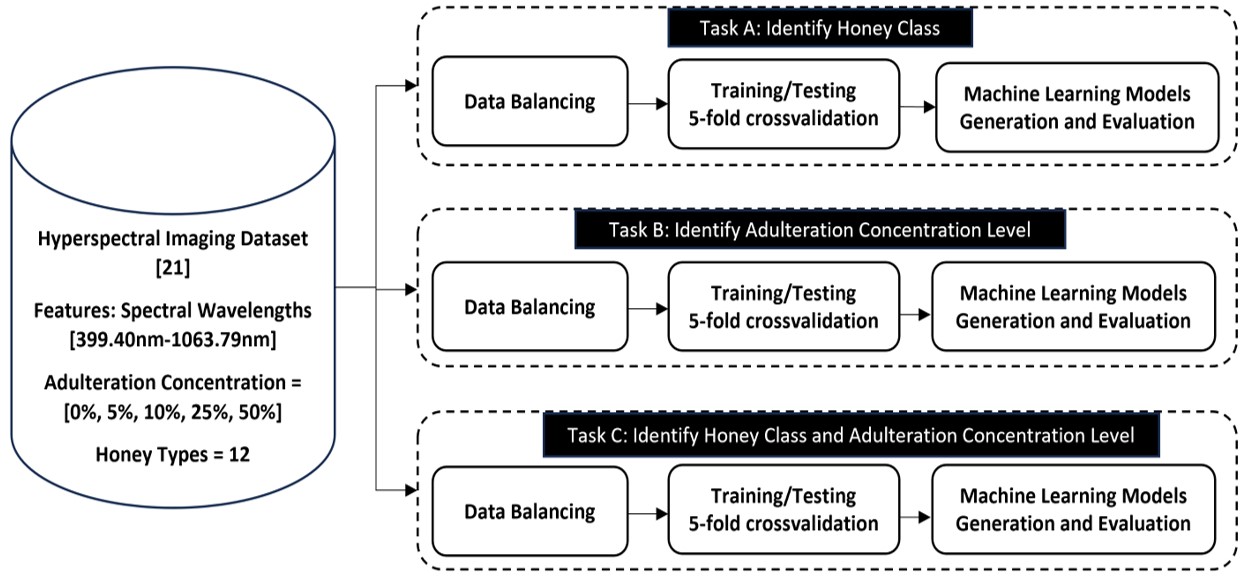Honey Adulteration Detection through Hyperspectral Imaging and Machine Learning
Keywords:
Honey Fraud Detection, Hyperspectral imaging, Machine Learning, Random Forest, XG Boost.Abstract
Introduction/Importance of Study:
The purity and authenticity of honey are paramount for ensuring consumer trust and maintaining the integrity of the honey industry. There is a pressing need for advanced and efficient detection methods to increase the prevalence of honey adulteration.
Novelty statement:
Our research provides a solution to the challenge of predicting the change in adulterated honey properties through hyperspectral imaging and advanced machine learning algorithms, filling a critical gap in existing methodologies.
Material and Method:
A publicly available dataset with spectral features, extracted through hyperspectral imaging, across different classes of honey and adulteration levels has been examined and various machine learning models were developed to identify honey adulteration concentration and type of honey. The dataset was balanced and a five-fold cross-validation technique was used to train the machine learning models.
Result and Discussion:
Random forest was found to perform better in three identified scenarios i.e. (a) type of honey (b) adulteration level (c) both (a, b); with a maximum average accuracy of 99.69% performing better than the one reported in the literature (95%). For both single-output and multiple-output ML models, the trend in feature importance was observed. The single model identifying the class of honey utilized low and mid-frequency spectra while the multi-model used mid-frequency spectrum only.
Concluding Remarks:
The proposed approach aims to provide an accurate and cost-effective solution to address the challenges associated with honey adulteration, contributing to the enhancement of honey quality assessment and consumer confidence.
References
A. Noviyanto, W. Abdullah, W. Yu, and Z. Salcic, “Research trends in optical spectrum for honey analysis,” 2015 Asia-Pacific Signal Inf. Process. Assoc. Annu. Summit Conf. APSIPA ASC 2015, pp. 416–425, Feb. 2016, doi: 10.1109/APSIPA.2015.7415305.
C. Cordella, I. Moussa, A. C. Martel, N. Sbirrazzouli, and L. Lizzani-Cuvelier, “Recent Developments in Food Characterization and Adulteration Detection: Technique-Oriented Perspectives,” J. Agric. Food Chem., vol. 50, no. 7, pp. 1751–1764, Mar. 2002, doi: 10.1021/JF011096Z.
P. Lindner, E. Bermann, and B. Gamarnik, “Characterization of Citrus Honey by Deuterium NMR,” J. Agric. Food Chem., vol. 44, no. 1, pp. 139–140, 1996, doi: 10.1021/JF950359K.
S. Giraudon, M. Danzart, and M. H. Merle, “Deuterium Nuclear Magnetic Resonance Spectroscopy and Stable Carbon Isotope Ratio Analysis/Mass Spectrometry of Certain Monofloral Honeys,” J. AOAC Int., vol. 83, no. 6, pp. 1401–1409, Nov. 2000, doi: 10.1093/JAOAC/83.6.1401.
S. T. Brookes, A. Barrie, and J. E. Davies, “A Rapid 13C/12C Test for Determination of Corn Syrups in Honey,” J. AOAC Int., vol. 74, no. 4, pp. 627–629, Jul. 1991, doi: 10.1093/JAOAC/74.4.627.
J. W. White, K. Winters, P. Martin, and A. Rossmann, “Stable Carbon Isotope Ratio Analysis of Honey: Validation of Internal Standard Procedure for Worldwide Application,” J. AOAC Int., vol. 81, no. 3, pp. 610–619, May 1998, doi: 10.1093/JAOAC/81.3.610.
S. Gok, M. Severcan, E. Goormaghtigh, I. Kandemir, and F. Severcan, “Differentiation of Anatolian honey samples from different botanical origins by ATR-FTIR spectroscopy using multivariate analysis,” Food Chem., vol. 170, pp. 234–240, Mar. 2015, doi: 10.1016/J.FOODCHEM.2014.08.040.
S. Sivakesava and J. Irudayaraj, “Detection of inverted beet sugar adulteration of honey by FTIR spectroscopy,” J. Sci. Food Agric., vol. 81, no. 8, pp. 683–690, Jun. 2001, doi: 10.1002/JSFA.858.
S. Sivakesave and J. Irudayaraj, “Prediction of Inverted Cane Sugar Adulteration of Honey by Fourier Transform Infrared Spectroscopy,” J. Food Sci., vol. 66, no. 7, pp. 972–978, Sep. 2001, doi: 10.1111/J.1365-2621.2001.TB08221.X.
J. Irudayaraj, F. Xu, and J. Tewari, “Rapid Determination of Invert Cane Sugar Adulteration in Honey Using FTIR Spectroscopy and Multivariate Analysis,” J. Food Sci., vol. 68, no. 6, pp. 2040–2045, Aug. 2003, doi: 10.1111/J.1365-2621.2003.TB07015.X.
G. ElMasry and D. W. Sun, “Principles of Hyperspectral Imaging Technology,” Hyperspectral Imaging Food Qual. Anal. Control, pp. 3–43, Jan. 2010, doi: 10.1016/B978-0-12-374753-2.10001-2.
A. A. Gowen, C. P. O’Donnell, P. J. Cullen, G. Downey, and J. M. Frias, “Hyperspectral imaging – an emerging process analytical tool for food quality and safety control,” Trends Food Sci. Technol., vol. 18, no. 12, pp. 590–598, Dec. 2007, doi: 10.1016/J.TIFS.2007.06.001.
S. Minaei et al., “VIS/NIR imaging application for honey floral origin determination,” Infrared Phys. Technol., vol. 86, pp. 218–225, Nov. 2017, doi: 10.1016/J.INFRARED.2017.09.001.
A. Noviyanto and W. H. Abdulla, “Honey botanical origin classification using hyperspectral imaging and machine learning,” J. Food Eng., vol. 265, p. 109684, Jan. 2020, doi: 10.1016/J.JFOODENG.2019.109684.
A. Noviyanto and W. H. Abdulla, “Signifying the information carrying bands of hyperspectral imaging for honey botanical origin classification,” J. Food Eng., vol. 292, p. 110281, Mar. 2021, doi: 10.1016/J.JFOODENG.2020.110281.
T. Phillips and W. Abdulla, “Class Embodiment Autoencoder (CEAE) for classifying the botanical origins of honey,” Int. Conf. Image Vis. Comput. New Zeal., vol. 2019-December, Dec. 2019, doi: 10.1109/IVCNZ48456.2019.8961004.
A. Noviyanto and W. H. Abdulla, “Honey dataset standard using hyperspectral imaging for machine learning problems,” 25th Eur. Signal Process. Conf. EUSIPCO 2017, vol. 2017-January, pp. 473–477, Oct. 2017, doi: 10.23919/EUSIPCO.2017.8081252.
T. Phillips and W. Abdulla, “A new honey adulteration detection approach using hyperspectral imaging and machine learning,” Eur. Food Res. Technol., vol. 249, no. 2, pp. 259–272, Feb. 2023, doi: 10.1007/S00217-022-04113-9/TABLES/6.
N. V. Chawla, K. W. Bowyer, L. O. Hall, and W. P. Kegelmeyer, “SMOTE: Synthetic Minority Over-sampling Technique,” J. Artif. Intell. Res., vol. 16, pp. 321–357, Jun. 2002, doi: 10.1613/JAIR.953.

Downloads
Published
How to Cite
Issue
Section
License
Copyright (c) 2024 50SEA

This work is licensed under a Creative Commons Attribution 4.0 International License.




















